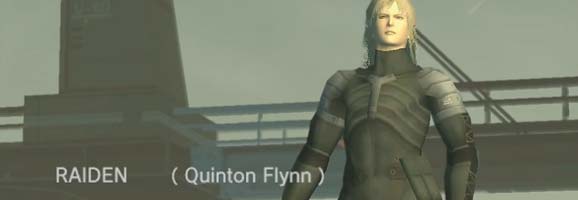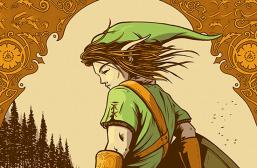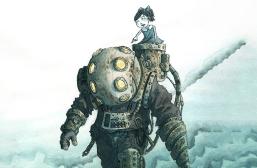Three Postmodern Games: Self-Reflexive Metacommentary
WARNING: Spoilers for Bioshock Infinite, Spec Ops: The Line, and Metal Gear Solid 2: Sons of Liberty follow!
Postmodernism is a bit of a loaded word within my circle of friends. Broadly defined, postmodernism is an “incredulity towards the metanarrative”, the rejection of a universal cultural mythos. The grand, Western narratives of religion, philosophy, and civilization were delegitimized by an increasingly globalized world filled with a plethora of worldviews; thus, relativism, subjectivity, and skepticism became the predominant response to the big questions. In the arts, postmodernism manifested as a mockery and challenge of previous conceptions of what art constitutes. Postmodern literature challenged the notion that narratives have to tell cohesive stories, Toni Morrison’s Beloved employs a fragmented narrative told by multiple narrators with subjective perceptions of reality and expects the reader to piece the plot back together and create their own subjective understanding. Marcel Duchamp challenged common understandings of what constitutes art by overturning a urinal and titling it Fountain.

If video games are art, and all art forms undergo some postmodern phase where they question form and subjectivity, then examples of postmodern video games must exist. Indeed, if we are to look beyond their status as a cultural commodity and the indistinction between “high and low gamer culture”, there exists a rich practice of challenging prior conceptions of what the medium can do. The most common postmodern practivce in video games is self-reflexivity, when a work of art raises questions about itself as a created construct. Self-reflexivity most often manifests as the “breaking of the fourth wall”, when on-screen characters seemingly become aware of their existence in an electronic game and engage with the player directly. Taking cues from film and literature, story-driven games have cleverly deployed self-reflexivity to critique formal issues such as the narrative limitations imposed by interactivity, society’s attraction to violence in entertainment, and geek culture’s disinterest in reality.
Bioshock Infinite follows Booker DeWitt’s journey into the floating utopia of Columbia to retrieve a psychic girl named Elizabeth for mysterious employers. A popular reading of the game, (read: mine) frames it as a “meta-commentary” on the problematic nature of video game storytelling. In its ending, Bioshock Infinite introduces a plot twist revealing that the game exists in a multiverse, where an infinite number of alternate timelines are generated by every possible choice that a player makes in a game. The universes are characterized by “constants” and “variables”, elements of the plot that are consistently the same across playthroughs, and elements that differ depending on player choice. On a self-reflexive level, these terms refer to embedded and emergent narrative in games, “constants” being embedded narrative elements such as cutscenes, dialogue, and background chatter, and “variables” being emergent elements such as character customization and combat tactics. For games like Bioshock Infinite, narrative is delivered as an incomplete product, players must fill in the blanks that the authors have left, creating their own, personal, version of Bioshock Infinite.
That said, games like Bioshock Infinite are incapable of creating player agency because the designer authors all possible choices and outcomes. Players are constrained to only the narrative and strategic paths that designers create. While interactivity allows for a rich range of narrative permutations, all is mooted by authorial intent and a fixed story arc. Nonetheless, story-driven games constantly seek to combine authored narrative and player-agency despite the fact that the two inherently contradict each other. How can Mass Effect or The Walking Dead provide a truly emergent, player-driven narrative when a writer pens all dialogue choices, determines where the story will go, and how it will all end?

Bioshock Infinite self-reflexively critiques this trend mechanically and narratively. Many story-driven attempt to provide the illusion of agency by allowing the player to make binary or semi-binary choices at key moments to influence the direction of the plot. Bioshock Infinite subverts this mechanical trope by adopting similar “decision-moments” at certain points of the game, such as the decision to choose between two different brooches for Elizabeth. Bioshock Infinite subverts player expectations by making these binary “decision-moments” wholly irrelevant to the narrative, most often leading to minor cosmetic differences on a few side characters. The game knowingly acknowledges that players have been conditioned by similar games to believe that these “decision-moments” are critical its narrative outcome. By making these decisions comparatively irrelavant, Bioshock Infinite raises the question of whether or not autonomy can exist when an omniscient game designer authors the outcomes of all these binary decision points, arguing that the pursuit of “narrative player agency” is futile.
A duo of characters named the Lutece Twins reinforces this critique of interactive narrative. The Luteces are extradimensional scientists who occasionally appear before Booker throughout his adventure, providing him with cryptic advice. They are based loosely off the titular characters of Tom Stoppard’s Rosencrantz and Guildenstern are Dead. In an early encounter, they hand Booker a coin and ask him to flip it, and it lands on heads, like it did for the last 122 times. A similar scene occurs in Rosencrantz and Guildenstern where the constant outcome of a coin-flip causes the characters to question whether an omniscient force dictates their existence. An omniscient force does indeed dictate the coin flip: Stoppard scripts the coin to always land on heads, just like how Bioshock Infinite’s coin is scripted to always land on heads. Thus, chaos and random chance cannot exist under the directorial omnipotence of an author.
The coin-flip scene in Bioshock Infinite represents an ideal point to give the player the choice to call heads or tails, but Booker is scripted to always call heads. This is meaningful within the context of the game; removing interactivity from the scene suggests that it is impossible for a scripted narrative to be truly player driven, and players have no choice in a story-driven game except to proceed down the designer-dictated narrative path.

While most story-driven games strive to make players autonomous agents enacting change upon the game’s world through their decisions, Bioshock Infinite posits that the nature of the medium prohibits this from happening because designer-authored narratives prohibit real autonomy. Rosencrantz and Guildenstern tried to escape their doom by fleeing to England, but they were rendered incapable of doing so by existing in an authored narrative. Because Booker DeWitt is a video game character, he ultimately has no agency over his decisions, as he is simply an avatar for the player. The player is in turn a non-autonomous actor controlled by the invisible hand of game design, she is unable to make choices outside of the ones that the game’s system allows and must continuously push Booker forward from chapter to chapter until the game concludes. Self-reflexivity manifests as metacommentary in Bioshock Infinite, which critiques the narrative limitations inherent to an interactive medium and the and Sisyphean pursuit of “player agency”.
Yager’s 2012 military shooter Spec Ops: The Line uses self-reflexivity to critique society’s attraction to violence in entertainment. Spec Ops follows Captain Walker, who goes through a surreal journey through a sand-buried Dubai, strongly suggested to be a personal hell. Spec Ops self-reflexively raises questions about the morality of enacting violence its own medium. This is achieved through the subversion of player expectations and visual pastiche of other games.

Spec Ops: The Line questions player motivations and the attraction to violence by making its moment-to-moment gunplay banal and repetitive. The only mechanical progression appears in the escalating brutality of Walker’s execution moves, which questions player motivations for continuing to play the game in spite of the gunplay’s repetitious nature. Generic packaging, deceptive marketing, and a formulaic opening trick the player into believing Spec Ops to be a standard Call of Duty knockoff. The game’s deliberate manipulation of player expectations allows it to harshly indict those players who were actually seeking cheap thrills or escapist fantasy from it.
The game’s story punishes player progression: Walker’s time in Dubai only gets darker, more surreal, and nonsensical as the game progresses, subverting the genre’s “empowerment fantasy” through ludonarrative dissonance. Spec Ops’ ending has Captain Walker confront Colonel Konrad, a projection of his subconscious guilt. Konrad dances along the fourth wall in this climactic sequence, stating that everything would have been better if Walker simply left Dubai. In context, this suggests that simply quitting and leaving the game unfinished would have been considered a legitimate, and far less destructive, conclusion to the game’s story.
Much like Bioshock Infinite, Spec Ops deals with the impossibility of free will in a story-driven game. Throughout his mission, Captain Walker consistently shifts culpability over his destructive actions onto Konrad, claiming that he left him with no choice. Given the game’s structure, it is inherently impossible for Walker to not cause the damage he does; the only way to progress in a shooter like Spec Ops is to kill people. Walker’s shifting of the blame onto Konrad, claiming that he was left without any choice, reflects the player’s shifting of culpability onto the game’s design, which provokes frustration within the player by leaving no choice but to proceed by causing paramount death and suffering in Dubai.
Outside of meta-commentary on choice and culpability, Spec Ops critiques the attraction to violent military shooters by employing visual pastiche of other games, most notably, entries in the Call of Duty franchise. A key sequence in Spec Ops pastiches the “Death from Above” level from Call of Duty 4: Modern Warfare. The game takes a satellite view of the battlefield as Walker uses a white phosphorus cannon against a battalion of soldiers. The player, trained by similar sequences in other games, is subconsciously attracted to firing upon large groups of enemies (represented by white dots) and explosive vehicles, as doing so leads to a high bodycount: a good thing in “Death from Above”. This tricks players by making the largest group of “enemies” fired upon a group of innocent refugees. By recontextualizing Call of Duty 4’s most revered level, Spec Ops deconstructs player expectations of what actions are rewarded in the context of a game’s narrative, causing uncanny discomfort, if not rage, in its players.

Spec Ops’ particular deployment of pastiche is self-reflexive because it acknowledges its own artificiality by adopting tropes from other games to raise issues about those games as a whole. Structurally, Spec Ops’ denouement is almost identical to Call of Duty: Modern Warfare 3’s. Both involve the protagonist storming the villain’s tower at the center of Dubai, ascending to the top floor for a final confrontation. Spec Ops derisively mocks Call of Duty by removing combat from this final confrontation as the few surviving enemy soldiers surrender. Walker ascends the tower to confront Konrad only to discover that the villain was ultimately imaginary. As the game concludes, Konrad addresses the player directly, “You’re here because you wanted to feel like something you’re not, a hero”, he says, as he raises a gun to Walker.
As a cohesive whole, Spec Ops looks beyond its own fiction, pointing its metaphorical crosshairs at the recent surfeit of military shooters. By pastiching popular games in the genre and depicting a narrative where player participation is destructive to the game world, Spec Ops raises questions about the fantastical nature of military shooters and society’s attraction to violence in its entertainment. Konrad posits that players are attracted to violent action games to fulfill a desire for self-glorification in a morally diametric world, deconstructing the shooter’s narrative of the power fantasy.
While the Metal Gear Solid series is known for a psychic commando who acknowledged his own artificiality by reading the player’s memory card, the series’ second game, Sons of Liberty, offers much more interesting examples of postmodern self-reflexivity. Metal Gear Solid 2 indicts and deconstructs geek culture and game sequels by subverting player expectations in an increasingly over-the-top way. These subversions begin with the game’s marketing within the context of its release.
The first Metal Gear Solid was one of the runaway hits of the Playstation era, selling several million copies and spawning an eager fandom clamoring for a sequel. The game’s creative director, Hideo Kojima, intended for the game to be a one-off project, and had no plans to continue with the series. Fans became so vehement that Konami eventually gave in and had Kojima start work on a sequel. The initial trailers marketed Metal Gear Solid 2 as an epic continuation of Solid Snake’s adventure, and it quickly became one of the most anticipated and expensive games of its time. When it was released, the game was everything that fans dreamed of. The opening Tanker mission was creatively designed, featured few game-interrupting codec sequences, and had ample fan-pleasing dialogue between beloved characters. The whole thing was excitingly paced and represented the exact kind of sequel that fans clamored for. That is, until the Tanker sank and Snake apparently died.

After that integral plot twist, players take control of Raiden, a golden-haired, effeminate, and oft-whiny operative, with extensive experience in virtual reality missions but no actual experience in the field of combat. Kojima was cognizant that fans would be infuriated at the realization that they would be controlling the unlikable Raiden for the rest of the game, and deliberately designed the opening sequences of his mission poorly. While the Tanker mission featured few gameplay interruptions and sophisticated level design that gave experienced players a lot of strategic freedom, Raiden’s mission was consistently interrupted by long-winded, unnecessary tutorials and Raiden slavishly taking orders from his superiors. The plot disregards the series’ fiction by jumping from magical-realism to histrionic silliness, introducing goofy twists such as vampires, a rollerskating fat man, and an Illuminati-like superpower. All this is reinforced by the game’s advertising, from which Raiden was completely absent. Raiden’s introduction contradicted practically all fan expectations of a proper sequel to Metal Gear Solid, and their outrage at being treated this way was palpable.
But thematically and artistically, Metal Gear Solid 2’s false-advertising and savaging of its own fanbase makes total sense. Raiden was trained as a soldier through virtual reality, playing through simulations of Snake’s previous missions, each of them “indistinguishable from the real thing”. In context, Raiden represents geek culture, he believes that he is qualified for his mission because he played as Snake in combat simulations, lending him a strange inability to grasp the increasingly surreal nature of his adventure. In postmodern philosophy, the term “hyperreality” refers to the inability of a consciousness to distinguish between reality and a simulation of reality, a habitual problem that geek and otaku culture is accused of suffering from. An incessant torrent of plot twists and gameplay sequences impounds this hyperreality, as the game continues, it is revealed that Raiden’s support team is really an AI simulation of Colonel Campbell and Rose, Raiden’s girlfriend, and that his entire mission was nothing but an elaborate simulation intended to condition Raiden into becoming the perfect replication of Solid Snake. In its final chapters, the game grows increasingly strange, code spews through walls, characters literally turn on infinite ammo cheats, and the game abandons its stealth mechanics with an ultraviolent shootout against a horde of ninjas. The penultimate confrontation pits Raiden against an army of giant robots in a TRON-like arena as pounding techno plays in the background. By the time the player physically encounters Rose at the game’s conclusion, the player is filled with doubt and confusion over whether or not what she sees is real, even in the context of the game.

Which all makes sense given Kojima’s initial reluctance to make Metal Gear Solid 2 in the first place. Postmodern themes like hyperreality, simulation, and simulacra, in combination with Raiden’s unwanted presence and the ambiguity of the entire plot, all alienate the hardcore fans that irked Konami for a sequel. As the game ends, Raiden rejects the player’s control by taking out a pair of dog tags labeled with the player’s name and throwing them into the distance. In a closing monologue, Snake asks the player to embrace subjectivity and disregard the search for an objective reality.
Granted, this is not the only valid interpretation of Metal Gear Solid 2, and much better writings exist from Leigh Alexander and Brett Fujioka, but the focus of this article is on video games that self-reflexively raise issues about their medium, and Metal Gear Solid 2 accomplishes this by subverting fan expectations of a sequel. For detailed analysis of Japanese postmodernism and Otaku culture, consider reading Hiroki Azuma’s “The Animalization of Otaku Culture”.
There are a number of games that I have not been able to cover in this article, such as Hotline Miami, a ludic condemnation of narrative games, and The Secret of Monkey Island, a self-aware point and click comedy. That said, these postmodern “games about games” all raise very interesting questions about the artificiality of fiction, player expectations, and relativism, giving developers very interesting material to design responses off of. If anything, the deconstruction of game-related issues prompts creative responses and better understandings of what an interactive medium can and cannot accomplish.
What do you think? Leave a comment.











Cracking article! BioShock Infinite is by far the best game that I have ever played. I have never played any other Bioshock game than Infinite, but now things changed. After years of having my brother talking about how good the original BioShock was I felt extremely tempted to try Infinite. I bought the game and I would never in the world imagine that I would be left willing to easily pay 500$ for it instead of the 60$. Much like a painting on the wall this is a classic and it is so extremely good that I could hang the physical game up on the wall just to get reminded of the wonderful story this game has to offer. lol
No really, to get these feelings from playing a game is very rare and extremely beautiful. I was in despair sometimes, I got slightly depressed, I fell in love, I got scared. I build up an emotional bond between Elisabeth that just made me want her to be OK and safe.
I’m really really late on this, but I just have to post this. Bioshock infinite was a great game, but felt more disjointed compared to the previous two installments. The “Bioshock” and “Bioshock 2” excelled in their non-gameplay elements that enhanced the gameplay. “Bioshock Infinite” seems bogged down by non-crucial elements that don’t really add to the gameplay, and in this respect, seems to be inferior than its predecessors. http://www.youtube.com/watch?v=IU_AG5MXohs Great video that touches on some of the issues.
The combat style of Spec Ops is unfortunately very mediocre. For a game with such a compelling narrative, the combat is the definition of generic. If I had to compare it to another game, I would compare it to Gears of War in fighting style.
That’s the point, the actively tries to alienate the player through boring gameplay. It means that the only reason players are sticking around is due to a fascination with violence (as the article said, mainly through Walker’s increasingly gruesome executions) and they can’t use “Oh but it’s just fun to shoot at dudes” as a defence. The fascination might be intellectual, narrative or visceral, but in the end it’s all violence.
which all ties into the game’s theme of cognitive dissonance. the player is being told that he’s destroying the game’s world in the story, but to progress, he must shoot a lot of dudes. That story-gameplay contradiction is called ludonarrative dissonance, and it works here to make the player feel uncomfortable and strange.
Really good article. As someone who’s never played the Metal Gear Series (except for Rising: Revengeance)I really liked the break down of Raiden’s first appearance.
Also, have you considered Spec Ops’s links to Joseph Conrad’s Heart of Darkness? It’s interesting to see how culture seems to produce a version of this story for each era going from European Imperialism through US expansion (Apocalypse Now) and into the modern day Middle Eastern conflicts… I wonder what the next title in this series will be reflecting on? And what media it will exist in, moving as it has from Literature to Film to Computer Game.
Space? Space? SPAAAAACE!
and yeah, I wanted to consider Spec Ops’ link to Heart of Darkness, but couldn’t really fit it into what i was trying to say about metacommentary.
also, we need a movie called the Revengers.
Very intriguing read. Now I need to track down Hiroki Azuma’s study.
Just stumbled on this after googling self-reflexive games. Fascinating read and I never thought of Sons of Liberty from that perspective. Highly convincing work. Well done.
A very interesting article, Mr. Wong. First off, as a major fan of video games and all of their potential as both entertainment and art, I am happy to see their aspects of the latter being explored. I see in the comments multiple mentions of comparing Spec Ops’ ties to Conrad’s Heart of Darkness and thereby Coppola’s Apocalypse Now. I don’t have enough experience with the game to draw any resolute conclusions, but it is intellectually stimulating nonetheless. I would disagree with a point I saw made in those same comments, however, wherein poor gameplay mechanics were said to be a deliberate means to draw more attention to Spec Ops’ own “metacommentary” on the gaming industry. While the developer’s definitely were looking for a more narrative, commentary-based experience, I highly doubt “bad” gameplay would ever be intentional. Overall, I enjoyed your writing and found it very thought provoking.
One of the best gaming-related pieces of writing I’ve ever read. Legitimately. I’ve come back to this several times over the years and finally decided to leave a comment.
Personally, I have always felt that video games represent a much better medium for the ideas of post-modernism than literature and film ever have. To the point that it’s a wonder that it’s not the way the majority of games handle story. It would make perfect sense, and it’s a constant disappointment to me that the vast majority of games continue to tell stories the way movies tell stories, with non-interactive cutscenes and dialogue. That’s not what games are good at. I groan in agony every time a game takes control away from me to turn into a movie. If I want to watch a movie, I’ll watch a movie, because it will almost assuredly be a better story experience than a game that sometimes turns into a movie.
Movies, in their early days, did the same thing. They copied literature. Movies had narrators, and we heard the internal thoughts of characters. Because that’s what books did. But then we learned that film has different strengths than literature and those things are a rarity now rather than the default. I anxiously await the day when game designers finally realize that games are not movies, are never going to be movies, and start telling the kind of stories that only games can tell. Dark Souls/Bloodborne, The Witness, The Talos Principle, Braid, Bastion, Transistor, Portal, The Stanley Parable, Shadow of the Colossus. Games that handle story like these need to be the default, rather than the rare exception.
I can’t prove that I am human because I do not know the singular form of a cats.
I want to point out that the degenerates on Reddit have an unassailably idiotic response to “postmodernism”, for which they failed to supply their own definitions. To the contemporary intellectual, postmodernism can be quite the pitfall, but regrettably less intellectual forum-dwellers are so far down in the pit that they don’t even seem to comprehend the depth of the fall. One poster described the proffered definition as being “vague” and “circular”, lacking “substance”. Personally, the very notion that “substance” can be found in the postmodern condition seems laughably ironic, as is the notion that such a substance ought to be neither vague nor circular, even in an age that owes its epistemology to phenomenologists such as Martin Heidegger. To demand substance of a philosophy which denies substantiality is even more tautological and self-defeating than to agree to such a philosophy; genuine postmodernists would find in such a dismissal only that much more “evidence” for their “claims”. Yet the principal irony is that people will still cling to the pursuit of this very dated and pre-modern certainty, yet rather than contending W!TH postmodernism they shrug it off as though it were only a matter of COMMON SENSE. The claims of post-structural philosophy are extremely subversive, but only a naive rationalist who has grown up in the saturation of this school of thought would shrug it off as an all-too-familiar ambiguity. Yet it seems almost needless to say that the problems of a century do not end in adolescence, nor even in any one life.
Now, then: to business.
1. The Stanley Parable.
If ever there was a naïve post-grad’s attempt to deconstruct Games as Such, it was this pretentious anti-Game. The most traditionally beneficent outcome feels disappointing, and all other roads only lead to mindless button-mashing, sometimes very, dangerously literally.
Stanley is not merely a commentary upon postmodernism or any postmodern theme; it is postmodernism incarnate!!
2. Doki Doki Literature Club.
Here you have a game that is actually good, but not because of its actual gameplay. Mostly, you are presented with a novel that you click through as saccharine dance music plays overhead, and your eyes are dazzled by the sultry view. By the end of it, however, immersion has gone beyond mere illusion. The game becomes “self-aware” and violates your boundaries. By the end of it, you wonder where your world ends and sheer madness begins.
3. Yume Nikki.
This game is one of my top five. Though an outcome exists, no instructions are given. The characters do not talk; there are no visible objectives outside of the exploration of dreams. The protagonist is apparently a recluse without any social identity. Be that as it may, any sense that you ascribe to her internal world is a matter of interpretative reaching. The design employs R.P.G. Maker, but not for an R.P.G. The music is often no longer than two seconds, looped. All things considered, however, it is one of the most inspiring feats in contemporary design that I have ever encountered. It’s the game I honestly wish that I had made, and completing it has helped to inform my corporate satire, which is the game that I wished Stanley Parable was.
4. Nier: Automata.
One expects postmodern themes in indie games, but one of the great things about the Japanese is that they can turn contemporary intellectualism into a mainstream commodity. Yoko Taro’s masterpiece is a war game saturated with pacifist undertones. Most of the Machines are named after modern philosophers, including a giant, flying worm called “Hegel” and a much smaller robot in a top hat named “Jean-Paul” who wants to lecture you on existentialism. On a much larger scale, the game has three main endings, each of which reveals a different dimension of the war and each of which is more depressing than the previous one. By the time that you finish the last chapter, any hope or solace which you might have collected along the way has been shattered, and against the backdrop of the bitter reality and pointlessness of the violence all temporary coping mechanisms turn against you as though they too were Machines from another planet. Becoming-human is no mean feat, and Taro uses science fiction, like Philip K. Dick does, to explore this existential problem while also bitterly mocking existentialism as a tradition. One can hardly get more postmodern.
5. Braid.
The word “braid” itself has multiple meanings herein, and all of the meanings are interwoven and connected as if by a braid, too, reminding me of Deleuze’s concept of a “rhizome”. This indie game is perhaps the most prone to projection. Feminists laid claim to its role reversals over a decade ago, to the chagrin of the Developer, who spoke up about the misunderstanding at a time when it was not considered gauche to marginalize feminism as someone else’s “own ideologies”. While the game is itself supposed to be a musing upon quantum physics, time, and nuclear war, its true postmodernism is in its design. What happens when you can reverse your mistakes? Sure: the technique is nothing new, considering Sands of Time and even that Xbox cat with his vacuum, but its application as a puzzle game subverts every element in the tradition of Marioesque side-scrolling platformers. Consider my favourite quote from this game, to sum up its postmodernity: “The Princess must be in another castle. I’ve never met her. Are you sure she exists?” Any artwork that lends itself as easily to Identity Politics as to Physics is postmodern. It’s no surprise that our generation’s flagship masterpiece in doing so happens to be an indie game.
That about wraps it up from me, but I should make some honourable mentions:
1. Deponia.
2. Undertale.
3. TouHou Project.
4. Secret of Monkey Island.
5. Depression Quest.
There are plenty more out there, whether or not they or their developers identify them as such.
[({R.G.)}]
“Broadly defined, postmodernism is an “incredulity towards the metanarrative”, the rejection of a universal cultural mythos.”
You’ve described modernism. Post modernism if anything as grown to re-appreciate the power of narrative.
The author’s definition of postmodernism is a little reductionist, but it is correct: challenging the validity and authority of dominant narratives, focusing rather on the diversity and subjective experiences.
Years late, but really enjoyed this read. It’s really got me thinking!
I agree that Bioshock Infinite and Spec Ops: The Line were both interesting postmodern commentaries on the nature of narrative, autonomy, violence etc. in games, but they still function within the confines of the thing they’re critiquing, rather than escaping it. The problem with Spec Ops is that it really does play like a Call of Duty knock-off, which makes it mechanically really rather uninteresting – the narrative has to swoop in and redeem it. Bioshock Infinite, on the other hand, is more linear and less emergent than its own predecessors – you could endlessly wander the halls of Rapture just observing Big Daddies do their rounds, set up fights between them and the bad guys (reapers?), lay traps, rescue or kill the Little Sisters. Bioshock reels in this nteresting systemic emergence to be more linear, and like Spec Ops needs to rely on high-brow storytelling and ideation to make up for it.
I don’t accept that it’s some great postmodern ‘trick’ to make the player play ‘a Call of Duty knockoff’ for 10 hours before making you realise it’s actually smarter than that.
It makes me wonder whether true postmodern games are the ones where deep emergent AI systems are designed, which make the game take on a life of its own as a result of various colliding elements. My examples of postmodern games would maybe be something like these:
Crusader Kings. Yes, it’s framed very distinctly in the medieval era and the whole game takes place within a specific context, but there are no goals, and beyond key historical events you’re entirely at the mercy of randomised events, interlocking AI systems and that can create an incredible story spanning hundreds of years that’s entirely unique from the next person’s. It takes these ‘constants and variables’ ideas that Bioshock Infinite ultimately depicted in a way that that game – disappointingly, in my mind – could only depict through heavily scripted narrative rather than
Or how about Elder Scrolls IV: Oblivion – a game that’s defined far less by its rote story that doesn’t offer much agency than it is by the endless emergent scenarios that rise up from its clunky but fascinating AI systems colliding with each other, throwing up an infinite wealth of little anecdotes and possibilities that continue to be posted on YouTube to this day.
By taking the story creation out of the hands of people inevitably influenced by cinema and culture at large and into the distinctly videogame ideas like algorithms, RNG, dynamic AI, I think you start being more subversive to existing narrative structures. While I’m no expert on postmodernism, I wonder if the free-flowing stories that emerge from colliding AI systems is a kind of videogame manifestation of Deleuze’s rhizomes – games that free themselves from vertical human-created narrative structures and endlessly branch off into the new. There is no goal, there is no ‘grand narrative’, there’s just totally unique story generation.